Below are 28 presentations from the Algal Feedstocks Technology Area presenting topics from algae technology to nutrient recycling.
|
The Department of Energy Bioenergy Technologies Office held its 2015 Project Peer Review. The five day event focused on the seven areas including: terrestrial feedstocks technology, algal feedstocks technology, biochemical conversion technology, thermochemical conversion technology, demonstration and market transformation technology, sustainability and strategic analysis technology and cookstoves technology. Below are 28 presentations from the Algal Feedstocks Technology Area presenting topics from algae technology to nutrient recycling.
1 Comment
The algae courses page has now been added to the academic section. This was a suggestion from one of the visitiors to the site, that I just expanded and added. I greatly appreciate any and all feedback.
In putting together the list of courses that are available, I discovered a course assembled by Dr. David Hanson, Sarah Joyce, and Kathrin Spendier from the University of New Mexico. I encourage you to check it out - Algal biofues: a multidisciplinary approach. Please check out the other courses listed and fill out the form with any others you may know of. Thank you! I wanted to thank a member from the community who shared the article entitled: "Lipid productivity as a key characteristic for choosing algal species for biodiesel production" by Griffiths and Harrison (2009).
I really like this paper as it reviews several important aspects from strain selection to scale up summarized from the literature. Topics covered:
Microalgae are a promising alternative source of lipid for biodiesel production. One of the most important decisions is the choice of species to use. High lipid productivity is a key desirable characteristic of a species for biodiesel production. This paper reviews information available in the literature on microalgal growth rates, lipid content and lipid productivities for 55 species of microalgae, including 17 Chlorophyta, 11 Bacillariophyta and five Cyanobacteria as well as other taxa. The data available in the literature are far from complete and rigorous comparison across experiments carried out under different conditions is not possible. However, the collated information provides a framework for decision-making and a starting point for further investigation of species selection. Shortcomings in the current dataset are highlighted. The importance of lipid productivity as a selection parameter over lipid content and growth rate individually is demonstrated. Melinda J. Griffiths and Susan T. L. Harrison. 2009. Journal of Applied Phycology. Volume 21, Number 5, 493-507, DOI: 10.1007/s10811-008-9392-7  Hydrocarbon phenotyping of algal species using pyrolysis-gas chromatography mass spectrometry came out in May of this year in BMC Biotechnology. What I liked about this paper was the use of free and open source software as well as the fact that this paper is available through open access for anyone to read. Dinesh Barupal (first author of the paper) was kind enough to take me through the process used in the paper in the paper when I visited Dr. Feihn’s lab. From what I saw, it is as easy as the papers outlines it to be! Advantages
Hydrocarbon profiles have a tremendous effect on the biofuel properties. Hydrocarbon profiles seem to be a secondary focus to oils, with most people focusing only on the final percentage of algae oils or lipids. Knowing which algae have hydrocarbon profiles best suited for biofuels, or which factors (temperature, lighting, nutrients etc) effect hydrocarbon profiles is important in producing consistent high grade biofuels. You can find the paper’s abstract below: Background Biofuels derived from algae biomass and algae lipids might reduce dependence on fossil fuels. Existing analytical techniques need to facilitate rapid characterization of algal species by phenotyping hydrocarbon-related constituents. Results In this study, we compared the hydrocarbon rich algae Botryococcus braunii against the photoautotrophic model algae Chlamydomonas reinhardtii using pyrolysis-gas chromatography quadrupole mass spectrometry (pyGC-MS). Sequences of up to 48 dried samples can be analyzed using pyGC-MS in an automated manner without any sample preparation. Chromatograms of 30-min run times are sufficient to profile pyrolysis products from C8 to C40 carbon chain length. The freely available software tools AMDIS and SpectConnect enables straightforward data processing. In Botryococcus samples, we identified fatty acids, vitamins, sterols and fatty acid esters and several long chain hydrocarbons. The algae species C. reinhardtii, B. braunii race A and B. braunii race B were readily discriminated using their hydrocarbon phenotypes. Substructure annotation and spectral clustering yielded network graphs of similar components for visual overviews of abundant and minor constituents. Conclusion Pyrolysis-GC-MS facilitates large scale screening of hydrocarbon phenotypes for comparisons of strain differences in algae or impact of altered growth and nutrient conditions.  Last Wednesday, the Department of Energy hosted a webinar entitled the “the promise and challenge of algae as a renewable source of biofuels.” Slides and presentations when available (within 7-10 days) will be posted here: http://www1.eere.energy.gov/biomass/webinars.html Topics that were of interest to me were algae funding, and the consortium. Increased algae funding The first presentation highlighted the Aquatic Species Programs total budget of $25 million dollars during the course of the project. Fast forward to 2010 and the DOE Biomass Program has made an investment of close to $180 million dollars! Funding was allocated for algae research and development as well as algae deployment projects including those below. Algae research and development funding
Consortiums Three consortiums presented at the webinar on their objectives. The consortiums are taking a holistic approach to developing algae fuels from crop protection to life cycles. It was really great to see all aspects being weighed into the development of the algae biofuels. The three consortiums are shown below. 
If you have any thoughts or comments about the webinar, I would be interested in seeing them in the comments section below. It seems like everywhere we turn now there is something about algae. Maybe that is just me, but there is no doubt there is an increase in research publications. There has been an interesting trend in the area of of research models for biofuels. Algae and microalgae for fuel have become incredibly hot research topics especially in biofuels. Using the database Scopus I searched the terms “algae”, “microalgae”, “Arabidopsis thaliana”, and “Escherichia coli” to find the number of publications for each year. When you look at the number of papers published per year for each term, and each term in relation to biofuel papers you see some interesting results. Algae, and microalgae publications are exploding! There are more publications related to algae for biofuels than there are for any of the other model systems. Now, I admit that the comparisons are not exactly fair since all algae species are bundled together and compared with specific model systems. However, it is likely that with the broad scope of algae that are being studied, a few model systems of algae will emerge for studying biofuels. One potential model system would be Botryococcus braunii which is a well known high oil producer of long chain hydrocarbons.
Publications of algae whose genomes are being sequenced at Joint Genome Institute The Department of Energy Joint Genome Institute currently has 60 algae genome projects underway with more in the works. Most algae strains whose genomes are being sequenced were selected based on the foundation of literature that is available on them or because of some unique characteristic. This has resulted in the majority of genome projects focused on Chlamydomonas and Chlorella. The graph below shows the number of publications for each strain of algae over the last 50 or so years. See the video below for a demonstration of viewing the data. Better yet go over to the about algae page and change settings to view the data. Enjoy! In the latest issue of Fast Company, they covered leading algae company Sapphire Energy and former BP refining chief Cynthia Warner (Currently President at Sapphire Energy). While it may not be a journal there are some important comments that were made. On the topic of commercialization time line the following comment was made. "We're trying to do in 10 years what agriculture has accomplished in 100 years, but we have two enormous advantages. One is that we're in the molecular era, so we can take things down to a single gene. Two is that we're dealing with single cells so we can grow 25 generations of crops in a year." Dr. Stephen Mayfield a founder of Sapphire Energy and director of San Diego Center for Algae Biotechnology Since microalgae is in the unique position of having received more attention and funding than it ever has, there is no question that we are in store for a number of potential breakthroughs in research. What we have done To document these breakthroughs, we have added a new and easy collaborative approach that will display a time line of events that have occurred in both algae research and the algae industry. The best part: you can contribute to it too using the form below the graph! The goal of this graph is to become the most comprehensive source for algae progress by tapping the community of experts (YOU!). Click on either time line to see or add to it. Time line of algae research Time line of the algae industry Richard Sears TED Talk “Planning for the end of oil” helped put things into perspective. While energy is probably one of the slowest moving sectors to adapt, it does adapt. In Sears talk he presents a historical graph of wood, coal, oil, natural gas, and nuclear in relation to their share as our primary energy source in the last 150 years. While renewable energy sources are not represented on this graph, I couldn’t help but imagine what the next 50 years will look like. Where will algae be on this graph? What innovation will continue this trend of decarbonizing our future energy systems? With progressing fields of science intersecting with engineering, there are some very exciting possibilities. Last month, the J. Craig Venter Institute announced that they had made the first synthetic cell. MIT’s Technology Review (TR) reported on it today. The concept of generating synthetic genomes as a way to produce desired products is the basis behind another one of Craig Venter’s other companies Synthetic Genomics. In TR’s story they point to the current cost barrier. “Developing these techniques took about $30 to $40 million in funding, mostly from the company Synthetic Genomics. The main cost of these experiments comes from the price of synthesizing DNA, which may go down as more researchers see the promise of these types of experiments. "Other groups aren't doing this because of the cost and because the methods have been difficult, but I'd like to think we're making the methods simple," says Daniel Gibson, associate professor at the Venter Institute. “ This high cost of synthetic biology approaches has allowed only the three best funded algae biofuel companies (Synthetic Genomics, Sapphire Energy, and Solazyme) to integrate it into their business strategy. Like everyone else, I am wondering where these companies are in their research and development? And when we will find algae on the primary energy graph? The San Diego Center for Algae Biotechnology (SD-CAB) held their first Algal Biofuels Symposium. The theme of this years symposium was, "The Science to Support Algal Biofuel Commercialization." I went out of my way to attend this event. (I drove 20 hours.) Presentations from both industry and the academic institutions were information packed and insightful. I have identified the presentation speakers and some notes that I took down from the symposium. Steve Kay (University of California San Diego) - Introduction Dr. Kay started the symposium off with an introduction and some of the goals of SD-CAB. One of SD-CAB's goals is to provide a "pipeline of people knowledgeable about algae." This speaks very loudly to the need for intellectual capital in this expanding industry. The industry is growing in a number of areas including publications, citations, patents, and funding as Kay showed from with the slides (see below). For the remainder of the symposium, Kay asked the audience to treat the science presented at the symposium in a "peer reviewed" way. Slides from Dr. Steve Kay's presentation are available on the SD-CAB website. (Click the link and they should open in a PDF) Below are some of the slides that I found very interesting. (Source: All images below are from Dr. Steve Kay's presentation) Steve Mayfield (University of California San Diego) Algal Biofuel: Where are we no, where are we going Mayfield's talk on “Algal biofuel: Where are we now, where we are going” puts energy into perspective with prediction that we currently spend $5.8 trillion on energy and that number is expected to nearly double by 2020 to $10.4 trillion. The situation only becomes more sobering with estimates that our current energy supplies will likely be consumed by 2099 if not sooner.  So what are our options? A diversified portfolio of solutions was presented each with their strengths and weaknesses. Algae's limiting factors are considered to be "scale and cost." The graph at the right shows some potential strategies and pricing necessary to reach cost effective biofuels. One factor that can be easy to lose sight of until the process needs to be scaled are the input costs. Inputs include carbon dioxide, water, nutrients, and sunlight. Fertilizer costs and crop productivity in agriculture share an inverse relationship. Historically, increased fertilizer costs result in lower crop productivity as farmers reduce their use of fertilizer. When Dr. Mayfield made this point it seemed obvious but really makes a person think about introducing a whole new form of agriculture. Other major areas of focus were on the biomass production, harvesting, and product extraction. Slides from Dr. Steve Mayfield’s presentation are available on the SD-CAB website. (Click the link and they should open in a PDF) Paul Falkowski (Rutgers University) Developing hypothesis‐driven algal biofuels research Dr. Falkowski discussed photosynthetic efficiency of algae, and its potential use for screening. However, he pointed out that there is currently no perfect optimization photosynthetic efficiency strategy for mass algae culture. In their screening process they also looked at the lipid accumulation. Dr. Falkowski co-wrote an editorial in Science last August about Future Energy Institutes. The editorial discusses the need for "investing in the brainpower" for Americas future of sustainability and economic strategies. Christophe Benning (Michigan State University) Identification of factors required for oil biosynthesis in microalgae Dr. Benning talk on the lipid metabolism in Chlamydamonus was very interesting and inlcuded a multiple technology approach. With over 30,000 mutants have been screened by their lab groups, their experience has shown that there was little variation or improvement in the mutants. He also mentioned it can be difficult maintain a unique phenotype due to the rapid doubling time of algae. While lipid accumulation commonly increases under nitrogen limitation in algae, it also occurs during iron limiting conditions. Ursula Goodenough (Washington University in St. Louis) Lipid body biogenesis in Chlamydomonas reinhardtii Dr. Goodenough reviewed the close out report from the Aquatic Species Program report and found that Chlamydamonus was not a lipid producer. However, their group found that Chlamydamonus was a lipid producer. In fact, a starchless mutant they found that the algae produces over 50% lipids. They also noticed that sulfur depletion induces lipid bodies. Susan Golden (University of California San Diego) Cyanobacteria: the other algae Dr. Golden gave an impressive talk about cyanobacteria and their potential in biofuels. Why is she studying cyanobacteria? There are 73 cyanobacterial genomes and 22 of those are currently in progress. The genomes are relatively small (1.6 to 9.0 Mb). It is transformable. In some of the results that they shared they discussed lipid production. They looked at a the genes that are associated with lipid profile modifications. Their work takes a very genetic approach to identify the which genes are responsible for different traits (secretion of fatty acids, filamentous traits). I was impressed to see to that actually went out into the field to collected production strains. This strategy can be difficult because you have to go through the process of making you collections axenic, and you are starting with little to know information science literature. In their screening process, they evaluated their strains under a variety of temperatures, salinities, pH conditions, and light intensities. From this screening and survey they grew the strain under outdoor conditions on a larger scale. As a result, they now have a candidate model organism that has commercial applications. Arthur Grossman (Carnegie Institution for Science, Stanford CA) Light and the production of biodiesel by algae; pros and cons Dr. Grossman said something that really resonated with me. "We are losing genes from the genetic dictionary." He said this after going through the background of energy usage, a warming climate, economics, etc. The reason that this had such big impact on me is because I think that it can be easy to lose sight of the long term strategy. Nature is rich in models and information that we can find useful applications for. if we lose that genetic information we lose something valuable. Grossman also proposed a heterotrophic approach to growing algae due to short crop turn around time, high cell density, and high oil content. This thought process came from his encounters with Solazyme. A few people had commented on the obstacles of capital costs and feedstock supply costs. Dr. Grossman closed his talk with an appropriate quote from Arthur C. Clarke: Every revolutionary idea seems to evoke three stages of reaction. They may be summed up by the phrases: 1- It's completely impossible. 2- It's possible, but it's not worth doing. 3- I said it was a good idea all along.
I have made two new maps to add to the resources here at Algae U.
Right now, there are 20 algae companies on the industry map, and 25 algae research institutions. I have made the algae maps public in hopes that people within the algae community will add to them and continually improve them. Thank you for your help!
|
Literature Review
A technical blog for algae. Archives
April 2015
Categories
All
|





















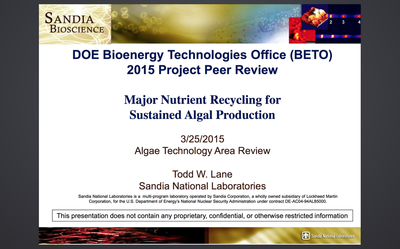





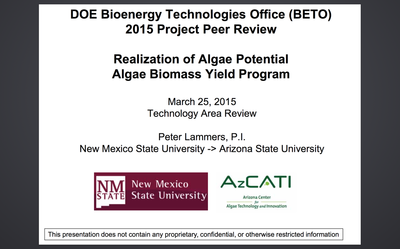
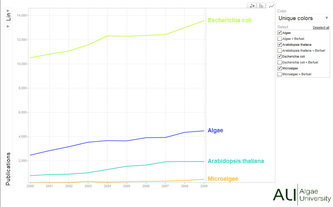

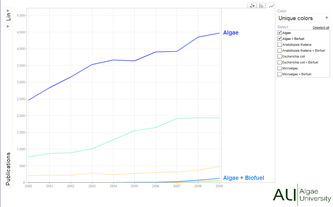
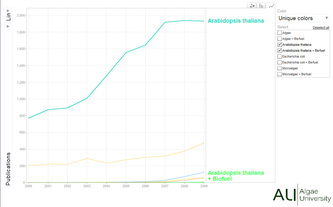


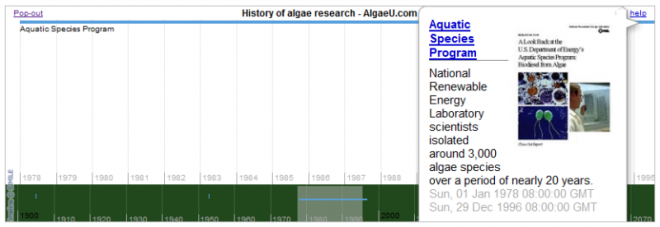





 RSS Feed
RSS Feed
